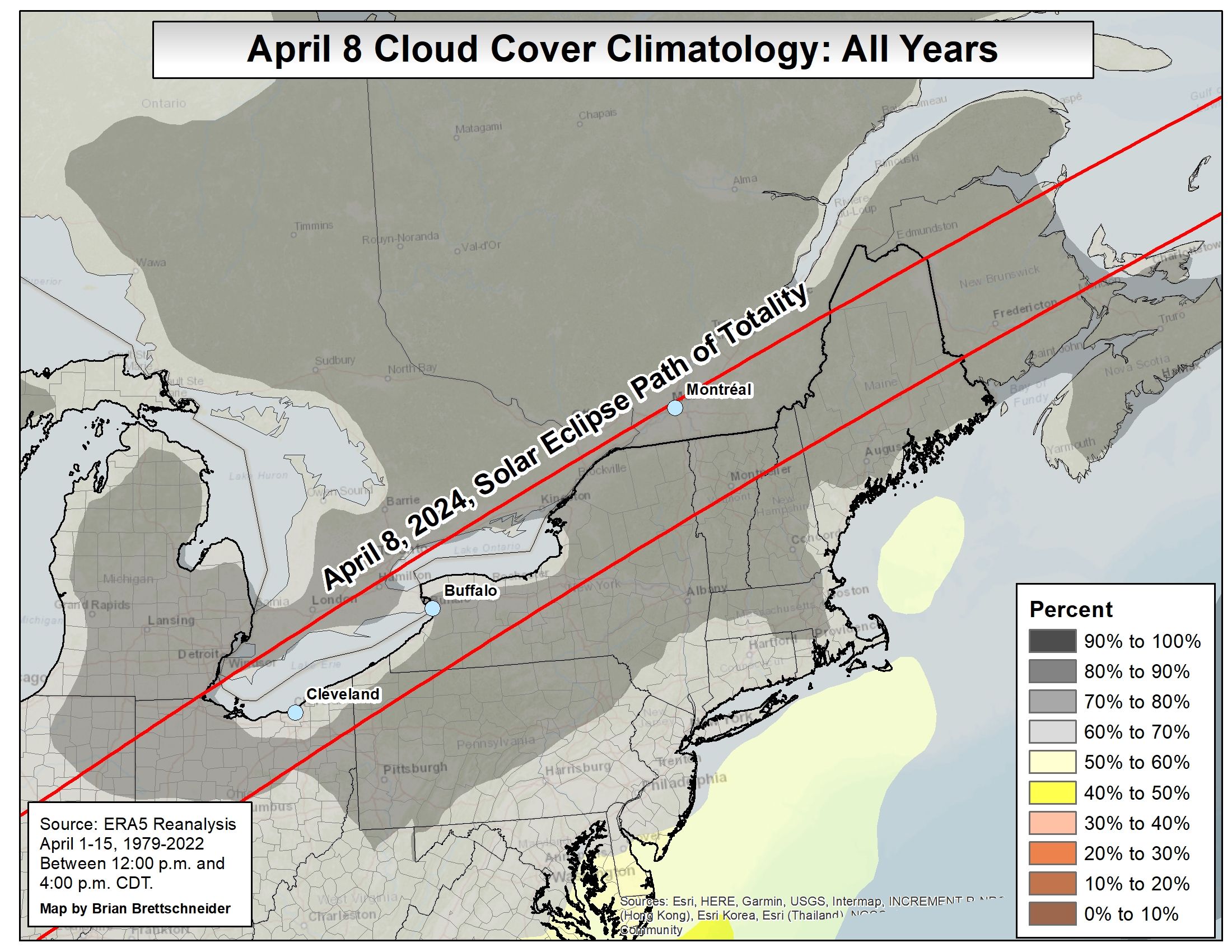|
On Monday April 8, 2024 a total solar eclipse will cross North America. The eclipse will be seen across portions of Mexico, the central and eastern United States, and southeastern Canada. The path of totality will first enter the United States in Texas, then advance northeast across the Mississippi and Ohio Valleys and reach New York State during the mid-afternoon. A solar eclipse occurs when the Moon passes between the Earth and the Sun at just the right time and orientation, with the Moon casting a shadow on a portion of the Earth's surface. Sometimes, the Moon only blocks part of the visible face of the Sun, which results in a partial solar eclipse. On more rare occasions, the Moon entirely blocks the face of the Sun and results in a total solar eclipse. Places in the path of totality, including most of Western and North Central NY, will experience several minutes of darkened sky similar to the twilight seen before sunrise or after sunset. If we have clear skies on the day of the eclipse, an incredible view of the Sun's corona will be seen during the few minutes of totality. The Sun's corona is normally not visible, except during a total solar eclipse. The corona is wispy, white streamers of plasma (charged gas) that radiate out from the surface of the sun. |
Image Courtesy of NASA |
Track and Timing of Eclipse Totality
| LOCATION |
PARTIAL ECLIPSE BEGINS |
TOTAL ECLIPSE BEGINS |
TOTAL ECLIPSE ENDS |
PARTIAL ECLIPSE ENDS |
|
Jamestown
|
2:03:38 PM EDT |
3:17:55 PM EDT |
3:20:46 PM EDT |
4:31:43 PM EDT |
|
Buffalo
|
2:04:56 PM EDT |
3:18:20 PM EDT |
3:22:06 PM EDT |
4:32:10 PM EDT |
|
Rochester
|
2:07:00 PM EDT |
3:20:08 PM EDT |
3:23:47 PM EDT |
4:33:26 PM EDT |
|
Watertown
|
2:10:05 PM EDT |
3:22:33 PM EDT |
3:26:12 PM EDT |
4:35:01 PM EDT |
Period of Record Begins:
Buffalo: 1871 Rochester: 1871 Watertown: 1950
Temperatures
| LOCATION |
AVERAGE HIGH |
AVERAGE LOW |
RECORD HIGH |
RECORD LOW |
RECORD COLD HIGH |
RECORD WARM LOW |
|
Buffalo
|
51 | 34 | 84 (2021) | 13 (1972) | 26 (1920) | 59 (1991) |
|
Rochester
|
53 | 34 | 80 (1991) | 17 (1972) | 27 (1972) | 60 (1991) |
|
Watertown
|
50 | 30 | 77 (2021) | 11 (1972) | 32 (2003) | 55 (1991) |
Precipitation
| LOCATION |
PERCENT OF DAYS WITH MEASURABLE PRECIPITATION (2000-2023) |
RECORD DAILY PRECIPITATION |
|
Buffalo
|
41% | 0.92" (2000) |
|
Rochester
|
44% | 1.02" (2000) |
|
Watertown
|
35% | 1.28" (2000) |
Snowfall
| LOCATION |
PERCENTAGE OF DAYS WITH MEASURABLE SNOWFALL (2000-2023) |
RECORD DAILY SNOWFALL |
|
Buffalo
|
19% | 3.4" (1957) |
|
Rochester
|
19% | 3.3" (1979) |
|
Watertown* *(from COOP Station) |
13% | 4.5" (1994) |
Cloud Cover
Below are maps of cloud cover climatology for the afternoon of April 8th. This climatology is based on an average of all years from 1979 to 2022. While early April is historically a cloudy time period in the eastern Great Lakes, there can still be sunny days in early April. Also of note, this cloud climatology includes days with high, thin overcast when at least some view of the Sun can still be available.
 |
 |
Satellite Imagery on April 8 from 1979 to 2023
Click on the image below to see a loop of visible satellite imagery over the central and eastern United States on the afternoon of April 8 from 1979 to 2023. This series of images will take you on a journey of our weather on April 8th for the past 44 years. The images are compiled from a series of NOAA weather satellites ranging from some of the early generation weather satellites in the 1970s to the modern weather satellites of today. Image loop courtesy of the Cooperative Institute for Meteorological Satellite Studies (CIMSS) at the University of Wisconsin-Madison.
Image Courtesy of the Cooperative Institute for Meteorological Satellite Studies (CIMSS)
Eye and Skin Safety During a Total Solar Eclipse
It is always harmful to your eyes to look directly at the Sun without specialized eye protection, with the exception of the few minutes during totality. Normal sunglasses DO NOT provide sufficient protection to look directly at the Sun, eclipse viewers will need special eclipse glasses or a handheld solar viewer. Looking at any part of the Sun through a camera lens, binoculars, or a telescope without a special-purpose solar filter secured over the front of the lens will cause severe eye injury.
Below are some important safety guidelines to follow during a total solar eclipse, courtesy of NASA:
Cold Water Safety
Water temperatures on Lake Erie and Lake Ontario in early April average mid 30s to lower 40s, so viewing the eclipse from a small boat can quickly become dangerous if an emergency occurs. Water temperatures on smaller inland lakes are also still very cold in early April. Water temperatures below 55 can cause cold water shock and hypothermia in a matter of minutes.
Additional Eclipse Resources and Links
Eclipse Websites
National Weather Service Cleveland, OH
National Weather Service Burlington, VT
NASA 2024 Total Solar Eclipse Website
New York State Department of Education Total Solar Eclipse Website
Travel and Traffic Websites
New York State 511 Travel and Traffic
Pennsylvania State 511 Travel and Traffic
Province of Ontario 511 Travel and Traffic
US/Canada Border Ports of Entry Status (Buffalo/Niagara Region)
Image Courtesy of NASA